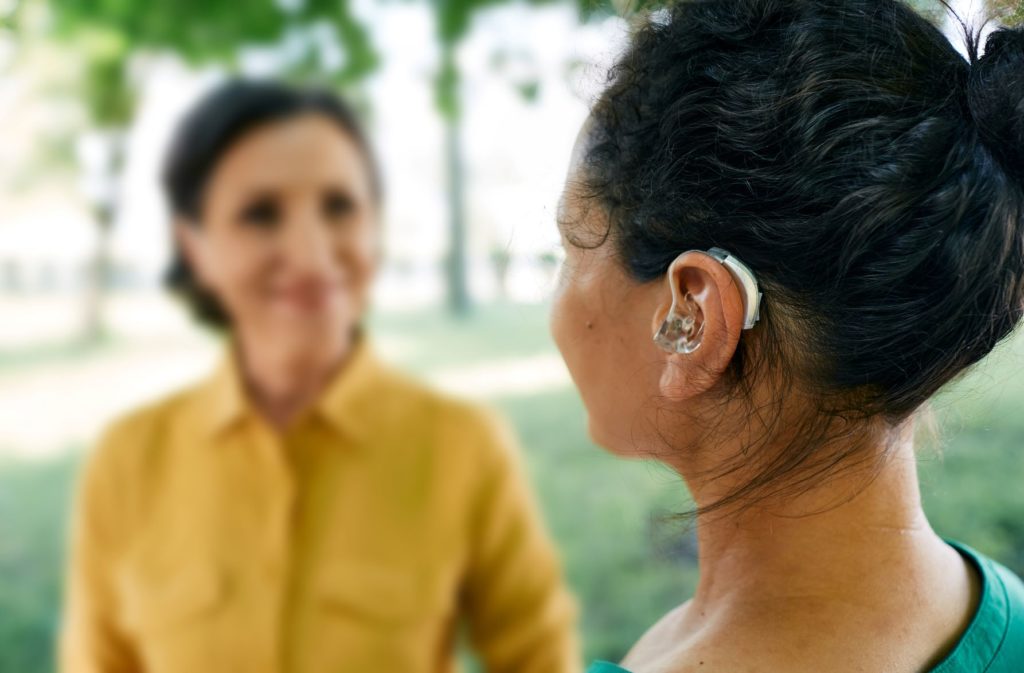Did you know that roughly 12 million adults in the UK suffer from a hearing impairment – that’s 1 in 5? Hearing loss has become the second-largest disability in the UK, however, it often goes unnoticed, meaning those suffering can also struggle with mental health issues due to feeling socially isolated and depressed.
There are many ways that we can help with how well we communicate with those with hearing loss. Below are some practices we can start to implement:
Note: It is important to understand that each hearing impairment is different, so each individual may have preferences regarding how they wish to communicate. Before starting a conversation, ask about their preferences and adjust accordingly, remaining respectful of their choices.
Face who you are speaking with
This may sound straightforward, but ensuring you can be seen clearly and with good lighting can more readily allow your facial expressions and body language to be registered, making communication easier. Using hand gestures and expressions like pointing and nodding, can also give visual cues, helping with the flow of the conversation. However, avoid unnecessary hand movements and/or covering your face and mouth when speaking, as this makes lip reading more difficult. It is also important to be at the same level as the person you are communicating with so ensure you sit if they are sitting or stand if they are standing so they can observe your facial expression and lip patterns.

Speak clearly
It is important to speak clearly and at a moderate pace while remaining relaxed. Try not to over-exaggerate your words as this can feel degrading and insulting for those with hearing impairments, instead aim to keep the conversation natural. It’s also important to note that shouting can heavily distort lip movements making it much more difficult to lip read; this further emphasises the need to talk naturally but with some added care. In addition shouting disrupts the natural music, or prosody, of language. We use this prosody to help us understand when a phrase or sentence has begun and ended. Shouting in a staccato voice will make all the words seem to blend together.
Get their attention
Another simple enough sounding technique, but vital, is ensuring you have the attention of who you’re talking to. This means there’s a lower risk of words being missed, allowing the conversation to flow without the need to repeat missed details. You can do this by saying the person’s name or positioning yourself in their line of sight. Avoid attempting to talk from another room or if they are concentrating on something else.
Reduce background noise
Excessive background noise can be distracting for anyone, including full-hearing people, so imagine how difficult it can be for those with a hearing impairment. Minimising background noise by either removing it (e.g. a tv) or moving to a quieter location means a person with a hearing impairment can more easily distinguish between sounds, and allow focus on the conversation you are having. Some people with hearing loss can also be sensitive to loud sounds, so avoid situations where this may be a factor in future meetings.
Rephrase, don’t repeat
If the listener has not understood the message the first time very often it will still sound unclear if you repeat in 2, 3 or more times. This is because the brain retains the message in short term memory while you are processing it and deciding how to respond. When you simply repeat the misunderstood phrase it is heard the same way as the initial speech so will still sound distorted. Try to re-phrase what you said using different key words so the listener gets a chance to re-interpret and understand what was said.

Write it down
If the situation calls for it, writing down what you want to say can be useful for someone with a hearing impairment. Information such as directions or work assignments may be a more efficient way to communicate if written down, either using paper or a smartphone. Always remain respectful of who you are speaking to, not assuming they need everything written down to converse with you.
Pay attention
Although these tips have focused on how you, a full-hearing person, can improve your communication techniques, it is important to remember that both parties are involved in this conversation. So when being spoken to, ensure that you are giving your full attention, remaining respectful of their style of communication. Be patient, maintain eye contact, and show intent with their responses. It will also be useful to recognise in their replies if they have understood you well and are on the same lines with the topic of conversation. If you’ve mentioned specific details, having the person repeat them back to you can help identify that you have been clear in your communication, meaning both parties are happy.
Assistive devices and technology
Finally, depending on who you are talking to, certain assistive devices may be of greater benefit in effective communication. Hearing aids and cochlear implants are useful for certain people with hearing impairment, so encouraging their use can benefit communication. Modern hearing aids can also benefit from remote FM microphones that close the distance between the speaker and listener and raise the speakers voice over any background noise. The Phonak Roger On is a good example of such a device that also processes the ambient noise to reduce it before your speech is sent to the hearing aid wearer.
The use of technology’s accessibility features such as subtitles and hearing aid-compatible phones could be a good addition if you have a friend or family member to suggest these options to.
Other methods
Some hard-of-hearing people may prefer to use other means of communication, for example, sign language or an interpreter. If there is someone in your life who uses sign language to communicate, it might be a good idea to learn sign language yourself. This would allow for a more comfortable style of communication and is a nice way to show your care for someone by learning. You can visit the British Sign Language website to utilise their tools and resources to get started today.
Top tips summarised
- Avoid speaking over each other and if you are in a group, aim to speak one at a time
- Don’t chew gum while speaking with a hearing-impaired person – this can make lip reading difficult
- If the person you are speaking with has one ear better than the other, try and take note and remember to direct your voice on that side
- Pay attention to their facial expressions, if they look confused, ask if they need you to repeat something
- Rephrase difficult words or expressions, especially if you notice they are struggling to understand
- Use helpful hand gestures and facial expressions where possible, but don’t overcomplicate them
- If you are meeting up with someone, try not to suggest loud and overcrowded venues, instead somewhere quiet with ample background noise would suit you better
If there is anyone in your life struggling with a hearing impairment, taking these steps can make a difference in their quality of life. Next time you are having a chat with one of these people, take a moment to put their preferences first whilst being conscious of your own actions and be the difference in combating the mental health tolls that being hard of hearing takes.
Give us a call on 0114 395 2039 or visit www.hearingtherapy.co.uk for help and advice on dealing with hearing loss and book an appointment today if you or a loved one are concerned about your hearing health. We are currently located in Sharrow Vale, Sheffield and offer various services including hearing tests, earwax removal, hearing aid advice and much more.
